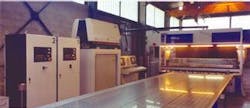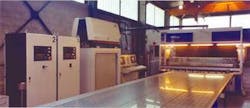Welding heat exchangers
The Netherlands, like all the Western industrial countries, is affected by the current economic downturn. In this time of recession the Dutch government has decided that the innovative capability of the Dutch Industry, especially of the SME's, needs to be improved in an attempt to change this situation. They therefore formed a workgroup called "Innovation Platform" chaired by the country's prime minister. It is widely believed that the role of universities and research institutes is essential in this innovation process, however, Omega Laser Systems is one company that has demonstrated that innovation depends mainly on the entrepreneurial spirit of people.
Twelve years ago Fred Jense and Herman Onk, two Dutch masters in mechanical engineering, started their own business manufacturing heat exchangers, which they named Omega Engineering B.V. The principal behind their production process is simple: weld two sheets of stainless steel together and hydroform the heat exchanger by pressing water into the space between them. Laser welding is definitely the most appropriate process for the job because it is fast, non-contact and, with the use of appropriate optics and numerical control, it has maximum flexibility and processing speed. Jense and Onk contacted several laser manufacturers and system integrators to find a system that was suited for their application. Finding no one that could build the laser welding system they needed, they designed and built their own system.
The heat exchanger welding system comprises a gantry mounting two laser welding heads each powered by a separate Rofin Sinar (Hamburg, Germany) CO2 laser controlled by a Siemens CNC controller (see photo). During the welding process two flat plates are clamped together and welded as the laser beam completely penetrates the thinner cover plate and partially penetrates the thicker base plate. The welding pattern is usually a circle combined with lines. The narrow fusion zone weld does not affect the cover side of the bottom plate, which can then be used as the inside of a tank. The plate is indexed through the gantry during the welding process in accordance with a stored computer program
Today the head office of Omega Engineering B.V. is still in Enschede, but the company has subsidiaries in the United States (Wisconsin) and South Africa where it manufactures heat exchangers for the local market. Short distance to customers means better communication and low transportation costs.
The laser system design was so successful they decided to found a new company, Omega Laser Systems B.V., to build special laser systems for customer requirements. Over the years Omega Laser Systems B.V. has built systems for welding, cutting, and marking for a wide range of customers. Their philosophy is to use machine parts from well-established suppliers, capable of worldwide service. They only develop what isn't available on the market and what gives the system the features that are needed by the specific customer, such as special optics and special software. During definition of the system and its design a close and intensive contact with the customer is essential. Manufacturing of details is subcontracted to local suppliers.
One of the special laser systems designed and built by a team of ten specialists is a CO2 laser to cut abrasives. This unit has a patented galvo mirror system that allows a 3kW laser beam to cut abrasive sheets at a speed of 3 m/sec. The system is built to customer requirements and can have up to three scanning heads. While the abrasive sheet is moving with a constant speed in one direction, the scanning heads ensure that the laser beams are following a contour that results in the proper shape of the product. The advantages of this system over conventional stamping systems are obvious: no wear of dies, maximum flexibility, and minimum waste. There is no need for space to hold the sheet during stamping so the products may "touch" each other. A side effect is that the waste material exits the system in small pieces and not as a sheet with holes that is difficult to handle. According to Fred Jense, the payback of such a system can be as short as 18 months.
Another interesting application that takes advantage of the galvo mirror system is the welding of tubes to sheets. In this application a welding speed in excess of 15 m/min (60 inch/min) is achieved.
Without the involvement of universities and research institutes the two founders of the mother company Omega Engineering B.V. have succeeded in setting up a company with an innovative type of heat exchanger, as well as creating a high-tech spin-off activity in the field of laser materials processing.
More interesting and impressive applications of Omega Laser Systems B.V. can be found on its Web site: www.omegalaser.com. The Web site www.omegaengineering.nl offers information about the products of Omega Engineering B.V. that are all produced by welding with lasers.
Martien van Dijk is a valued contributor to ILS. He can be contacted at [email protected].

